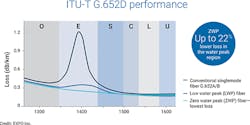Last month I wrote about the fiber optic term windows which was dominantly used in the early decades of fiber optics and is still used with multimode systems. While the term windows has been accepted by the fiber industry, it has never been fully defined and specified in a standard.
This isn’t the case with the term bands which became standardized by the International Standards Union (ITU) in 2003 with the ITU-T G series 39 recommendation titled, "Transmission Systems and Media/Digital Systems and Networks – Optical System Design and Engineering".
The bands defined by the ITU covered all wavelengths available for use with single-mode fibers. (Image courtesy of EXFO Inc.)
History Matters
What instigated the recommendation was the development of new products and technologies in the 1990s. This included optical amplifiers, new types of optical fibers, and dense wavelength division multiplexing (DWDM) systems. The ITU recognized that there was a need to specify wavelengths, spectrums and frequency grids resulting in the ITU-T G.692 and G.694 standards released in 1998 and 2002.
DWDM systems required tight specifications for lasers including the erbium-doped fiber amplifier (EDFA) used in long distance applications. As the spectral range of the EDFA was between 1530–1565 nm. This spectrum would be the foundation of the wavelength assignments and would be standardized as the conventional band (C-band). The adjacent bands would be the short (S-band) from 1460 nm to 1530 nm and the long band (L-Band) from 1565 nm to 1625 nm. The 1625 to 1675 nm spectrum would be specified as the Ultra long band (U-Band).
Still two wavelength spectrums needed to be specified. These were the original band (O-band) with a center wavelength of 1310 nm and ranged from the 1260 nm cut off wavelength (for most G.652 fibers) up to 1360 nm. This left the optical spectrum of 1360 nm to 1460 nm which the industry had stayed away from due to the hydrogen intrusion (OH) problem centered around 1383 nm. This spectrum would be defined as the Extended band (E-band). With newer low water peak single-mode fibers defined in the ITU-T G.652D standard this opened up the E-band for additional use.
Today DWDM systems can transmit up to 160 wavelengths using the C and L bands with their assigned channel spacings and wavelength bands. Laser and fiber manufacturers specify their products with the well-defined band terminology.
The initial use of bands specified very tight tolerance and high-performance systems. The use of lower cost uncooled laser diodes requires wider channels than DWDM systems. Called coarse wavelength division multiplexing (CWDM) 18 channels with 20 nanometers wide spacings are assigned from 1271 nm to 1611 nm. These channels were standardized by the ITU in 2002 with the ITU-T G.694.1 standard.
Like this Article?
Subscribe to ISE magazine and start receiving your FREE monthly copy today!
One exception defining optical spectrums is the ITU’s passive optical network (PON) systems which use the term bands for use with downstream and RF overlay systems defining spectrums for downstream transmission. The "Basic" band (1480 to 1500 nm) is used for downstream transmission, and RF overlay uses the "Enhancement" band (1550 to 1560 nm). Therefore, we should be careful with the term E-band as there are 2, depending on the application.
In the future, modulation formats and higher speeds, and the need to address optical signal noise ratios (OSNR), will require the industry and standards groups to respond to tighter wavelength assignments.






